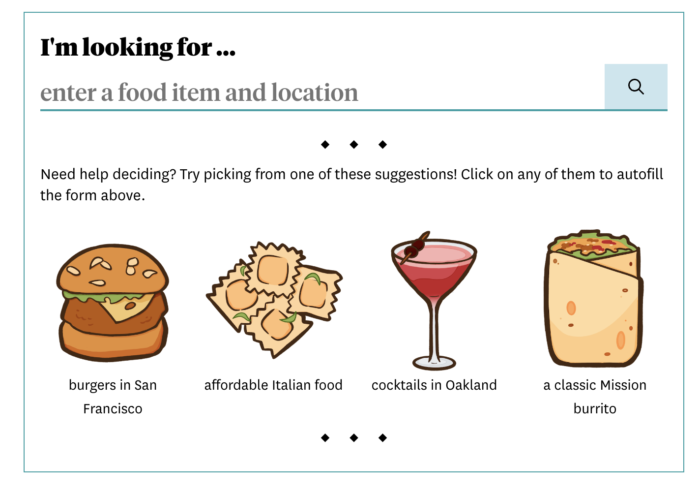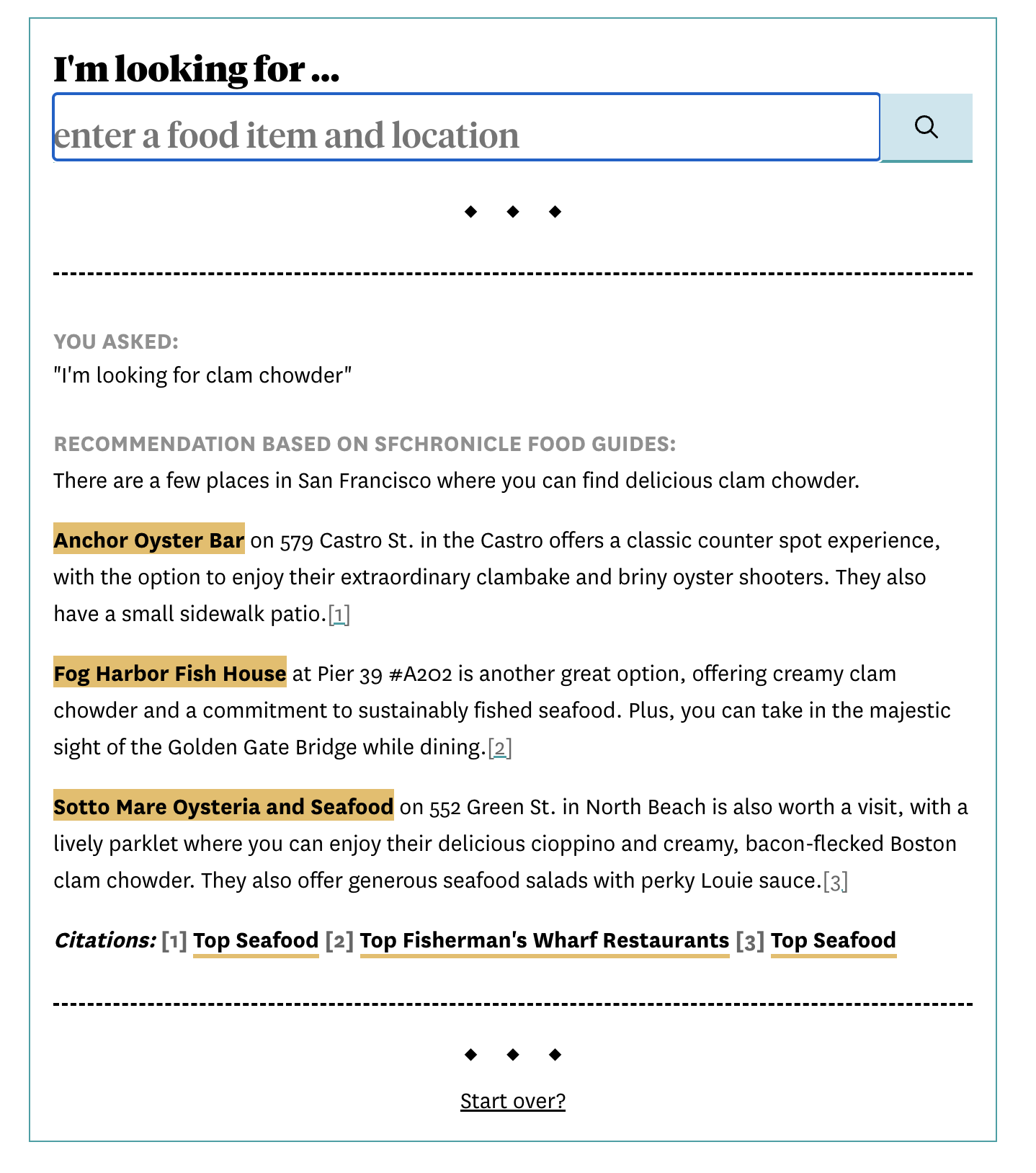
The San Francisco Chronicle is experimenting with an AI-powered chatbot to help readers find recommended restaurants and specific dishes throughout the Bay area. The, uh, Chowbot is the news org’s “first real foray into audience-facing AI,” editor of emerging product Sarah Feldberg told me.
Chowbot went live on Monday, alongside a Q&A with the paper’s food and wine editor, Janelle Bitker, and a more technical explainer. In those missives, the Chronicle assures readers the Chowbot is trustworthy because of the source material: the paper’s own “constantly updated” guides and reviews. While the recommendations are AI-generated, every restaurant that the bot suggests has been vetted and visited by a real human on the Chronicle staff. Feldberg said early reader queries have included gluten-free options, vegetarian dim sum, fried chicken, and restaurants for a celebration.
Bitker sees Chowbot as “a reader-friendly tool” that “accentuates” — rather than replaces — the work of the food and wine team. (As she tells readers: “I’d like to see a bot try to eat at four pizzerias in one day!”) Here’s Bitker on why the Chronicle wanted to test an AI chatbot in the first place:
We have a lot of restaurant guides. Our critics have eaten all over the Bay Area and have written up the best in the form of Top Restaurants lists — Top Pizza! Top Brunch! Top Dim Sum! — over the past few years. It’s a lot of content for readers to sift through to find exactly what they’re looking for. They might not even realize we have a guide dedicated to, say, french fries. The goal is for this bot to make getting a recommendation easier. And to have some fun!
When you type in a question, the bot essentially searches through a database of Chronicle food guides to find an answer. It focuses on factual information, so if you are looking for, say, the “best bagel in S.F.,” it’ll give you recommendations for great bagels based on our lists and reviews. But it doesn’t necessarily represent what our critics think is the No. 1 Very Best Bagel. For that, you’ll have to ask a human! And if you want to get more technical, I’ll need to phone a friend.
Breaking information out of news articles for answer-seeking readers is a promising application for AI in journalism. And it’s one that I expect we’re going to see tried at publishers of all sizes and stripes. Before Chowbot drew on hundreds of local restaurant reviews, for example, this Brazilian fact-checking bot was searching its own archives and BloombergGPT was being built on billions of bites of financial information.
Ryan Serpico, one of the developers behind Chowbot, is a former data and graphics reporter who joined Hearst Newspapers DevHub last year to focus on developing AI projects for local news. (Hearst acquired the San Francisco Chronicle in 2000.) Serpico explained the multistep journey taken by each Chowbot query from a content moderation check through an embeddings model to a “fine-tuned version of GPT-3.5-Turbo” to, if necessary, a fallback search for general guides.
The embeddings — which, fun fact, work for reasons “nobody fully understands” — are what allows Chowbot to take into account the “vibes” of the hundreds of restaurants in the Chronicle’s database. “If you were to ask Chowbot for pizza places in San Francisco, for example, Italian restaurants would be closer in ‘vibes’ than sushi restaurants would be,” Serpico noted to readers.
So — how good is Chowbot? And what can’t it do? Here’s Bitker again:
The bot is great at recommending a restaurant for a specific food you’re looking for, such as hummus or Dungeness crab. It can also look for such restaurants in specific San Francisco neighborhoods, near certain San Francisco landmarks (such as the Chase Center) or in other Bay Area cities generally. Right now, it can’t search within neighborhoods in other cities, like Oakland’s Temescal, for example. (But it can differentiate between the city of Richmond and the Richmond in San Francisco, which is pretty good, right?)
We have designed the bot to only look within our database of Chronicle reviews. So if you are looking for, say, a great kale smoothie … well, sorry, our critics haven’t written any guides to smoothies (yet … and if you’re interested in that, let us know!). Rather than guess what you want and recommend something else, like a coffee shop with smoothies, the bot will simply say it doesn’t have an answer for you. We’ve also designed the bot to stay 100% focused on what is written in our reviews, so it won’t always have answers on more subjective matters, like atmosphere or noise level.
Another of the questions — “Can Chowbot get it wrong?” — has a short answer. Yes.
“Despite Chowbot’s answers being grounded in the work of the Chronicle’s Food + Wine team, Chowbot is not immune to the hallucinations that plague all software that is powered by large language models, including OpenAI’s ChatGPT and Google’s Gemini,” Bitker writes. “Those two companies have thousands of employees working on this technology. If they encounter these issues, we likely will, too.”
I put the chatbot through its paces, asking after banh mi, clam chowder, and a vegan breakfast sandwich. Chowbot did the best with clam chowder, returning three options and citing two different Chronicle articles. All three are real restaurants and — I checked! — currently have clam chowder on their menus.

For my banh mi hankering, it had one recommendation: the small San Jose-based chain Duc Huong. My friend Bethany, a vegan willing to go great lengths for a breakfast sandwich, would be out of luck, however. Chowbot didn’t have specific recommendations for her and could only point to guides on the “best vegetarian and vegan restaurants in the SF Bay Area” and the “best lunch restaurants in downtown San Francisco.” But, hey, it didn’t make anything up or send her on a wild goose chase unlikely to end in Beyond Sausage and Violife cheddar either.
The Chowbot is live and spitting recommendations. Readers can try it out here.